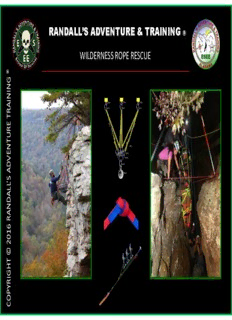
randall's adventure & training ® wilderness rope rescue PDF
Preview randall's adventure & training ® wilderness rope rescue
RANDALL’S ADVENTURE & TRAINING ® WILDERNESS ROPE RESCUE ® G N I N I A R T E R U T N E V D A S ’ L L A D N A R 6 1 0 2 © T H G I R Y P O C RANDALL’S ADVENTURE TRAINING ® WILDERNESS ROPE RESCUE ® G N I N COURSE PURPOSE I A R T E R U T This course is designed to merge standard rescue practices with single-rope N E techniques often found in mountaineering, caving and canyoneering rescues. V D A S Some of the practices in this course depart from the NFPA rope rescue course format ’ L L A due to the safety factor ratios when using lighter, faster equipment, as well as the use D N of single rope techniques for some rescue scenarios. A R 4 1 It should be noted that the safest practice is to always use rated equipment and 0 2 independent belays when possible. © T H Course Hours: 30 Hours Abbreviated, 50 Hours Complete G I R Y P O C RANDALL’S ADVENTURE TRAINING ® WILDERNESS ROPE RESCUE ® G N I N TYPICAL RESCUE SCENARIOS I A R T E R U T • Injured climber on rope (conscience or unconscious). N E V • Injured or non-injured person trapped in a confined space or extremely D A dangerous terrain (caves, canyons, etc.). S • Falls in a high angle environment. ’ L L A • Short Roped (rope doesn’t reach the bottom and climber can’t get back up D N the rope). A R • Climber stuck on a rope due to equipment failure or jams. 4 1 • Un-roped hiker/climber stuck on a ledge or high point. 0 2 • Equipment Problems / Failures. © T H G I R Y P O C RANDALL’S ADVENTURE TRAINING ® WILDERNESS ROPE RESCUE ® G N I N THIS COURSE CONSISTS OF: I A R T E R Safety U T Equipment N E Knots V D Anchors A S Single Rope Descending ’ L L Single Rope Ascending A D Belays N A Pick-Off Rescues R 4 Lowering / Raising Systems 1 0 Mechanical Advantage 2 © System Changeovers T Knot Passes H G Litters / Patient Packaging I R Y Horizontal Line Basics P O C RANDALL’S ADVENTURE TRAINING ® WILDERNESS ROPE RESCUE ® G N I N MINIMAL EQUIPMENT REQUIREMENTS: I A R T E R U T Static Kernmantle Rope N E Webbing V D A Locking Carabiners S Descending Device(s) ’ L L A Ascending Device(s) D N Anchorage A R Prusik Cords 4 1 Class II Harness 0 2 Helmet © Gloves T H Helmet Light G I R Y P O C RANDALL’S ADVENTURE TRAINING ® WILDERNESS ROPE RESCUE ® G N I N CONCEPT OF RESCUE I A R T E R U T N L.A.S.T. E V D A S ’ L L A D L - Locate N A R A - Assess 4 1 S - Stabilize 0 2 © T - Transport T H G I R Y P O C RANDALL’S ADVENTURE TRAINING ® WILDERNESS ROPE RESCUE ® G N I ROPE RESCUE SYSTEM ANALYSIS N I A R T E R U T N E V D WHITEBOARD A S ’ L L CRITICAL POINT A D N A WHISTLE TEST R 4 1 0 2 © T H G I R Y P O C RANDALL’S ADVENTURE TRAINING ® WILDERNESS ROPE RESCUE ® G N I N OPERATING SAFELY I A R T E R U Safe rope operations can be divided into four areas: T N E V 1) Learning the skills (Getting the basics down correctly!) D A 2) System setup (Use the best equipment without weak links) S ’ L 3) Checking (Always double check to prevent mistakes) L A D 4) Belaying (Rigging it properly to catch any mistakes in 1-3 above) N A R 4 1 0 2 © T H G I R Y P O C RANDALL’S ADVENTURE TRAINING ® WILDERNESS ROPE RESCUE ® G N SAFETY I N I A R T 1. Work a buddy system. E R 2. Speak up, regardless of your skill level. U T 3. Use the “Touch” System to verify all rigging. N E 4. Never use questionable equipment. V D 5. Always use a safety line when working within 10’ of the edge. A S 6. Always consider your margin of safety. (For example, if you weigh 170 ’ L L pounds and the rope you are rappelling on is only rated for 200 pounds, then A D your margin of safety is slightly better than 1:1. The slightest increase in N load such as a sudden stop may cause the system to fail.) A R 7. The rescuer’s safety comes first! 4 1 0 Most experts suggest a 10:1 factor for SRT and a 15:1 factor for rescue operations. 2 © T When working around a high-angle environment, every team member must H wear a safety helmet, harness, gloves and safety line. G I R Y P There is ALWAYS time for safety! O C RANDALL’S ADVENTURE TRAINING ® WILDERNESS ROPE RESCUE ® G N I N I <Go over classroom handout on Safety Rules> A R T E R U T N E V D A S ’ L L A D N A R 4 1 0 2 © T H G I R Y P O C
Description: